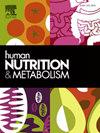Predictors of treatment outcome among severe acute malnutrition children admitted inpatient therapeutic feeding center in public health facilities of Jigjiga Town, Somali Region, Ethiopia
IF 1.8
Q3 ENDOCRINOLOGY & METABOLISM
引用次数: 0
Abstract
Background
Severe acute malnutrition (SAM) is a major public health problem in Ethiopia, with inconsistent and inconclusive treatment outcomes, particularly in the study area.
Objective
Therefore, this study aims to assess the predictors of outcome treatment among SAM under-five children admitted to stabilization centers in public health facilities in Jigjiga Town, Somali Region, Ethiopia, 2021.
Methods
A retrospective cohort study at Jigjiga Referral Hospital with 418 participants used checklist data entered EPI Data 3.1 and analyzed in SPSS 23, employing Kaplan-Meier and Cox regression to assess variables' association with recovery rate, including significant predictors (p < 0.05) identified through bivariate and multivariate Cox models, and hazard ratios (HR) with 95 % CI.
Results
The recovery rate was 62.2 % with a median nutritional recovery time of 13 days. Vitamin A supplementation 1.4(AHR = 1.405 95 % CI: 1.058, 1.865), received plump nut 1.8 (AHR = 1.8, 95 % 1.250, 2.585) pneumonia 0.684 (AHR = 0.684, 95 % CI: 0.508, 0.921), history of diarrhea 0.614(AHR = 0.614, 95 % CI: 0.435, 0.866), correctly filled multi-chart 1.37 1.379 (AHR = 1.379, 95 % CI: 1.060, 1.795) were significantly associated the recovery rate.
Conclusion
The study found that the recovery rate remains low compared to the WHO Sphere standard benchmark and similar studies conducted in Ethiopia. To improve the recovery rate, interventions should prioritize ensuring accurate and complete chart documentation by healthcare providers and incorporating nutritional supplements such as Vitamin A.
埃塞俄比亚索马里地区吉吉加镇公共卫生机构治疗性喂养中心收治的严重急性营养不良儿童治疗结果的预测因素
严重急性营养不良(SAM)是埃塞俄比亚的一个主要公共卫生问题,治疗结果不一致且不确定,特别是在研究地区。因此,本研究旨在评估2021年埃塞俄比亚索马里地区吉吉加镇公共卫生机构稳定中心收治的5岁以下SAM儿童结局治疗的预测因素。方法对吉吉加转诊医院418名患者进行回顾性队列研究,使用EPI数据3.1输入的检查表数据,并在SPSS 23中进行分析,采用Kaplan-Meier和Cox回归评估变量与康复率的相关性,包括显著预测因子(p <;0.05),通过双变量和多变量Cox模型确定,风险比(HR)为95% CI。结果康复率为62.2%,营养恢复时间中位数为13 d。维生素A补充1.4(AHR = 1.405 95% CI: 1.058, 1.865)、吃饱满坚果1.8 (AHR = 1.8, 95% 1.250, 2.585)、肺炎0.684 (AHR = 0.684, 95% CI: 0.508, 0.921)、腹泻史0.614(AHR = 0.614, 95% CI: 0.435, 0.866)、正确填写多图1.37,1.379 (AHR = 1.379, 95% CI: 1.060, 1.795)与康复率显著相关。结论本研究发现,与世卫组织球体标准基准和在埃塞俄比亚进行的类似研究相比,回收率仍然较低。为了提高康复率,干预措施应优先确保医疗保健提供者提供准确和完整的图表文件,并纳入维生素A等营养补充剂。
本文章由计算机程序翻译,如有差异,请以英文原文为准。
求助全文
约1分钟内获得全文
求助全文
来源期刊

Human Nutrition and Metabolism
Agricultural and Biological Sciences-Food Science
CiteScore
1.50
自引率
0.00%
发文量
30
审稿时长
188 days
 求助内容:
求助内容: 应助结果提醒方式:
应助结果提醒方式:


